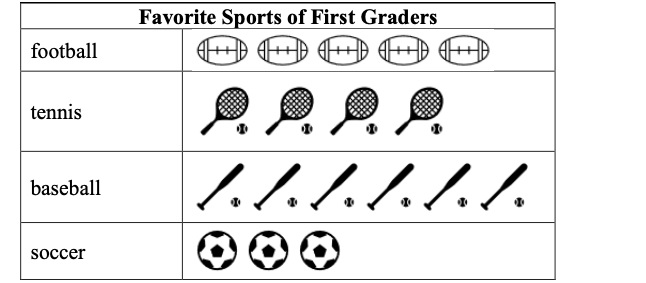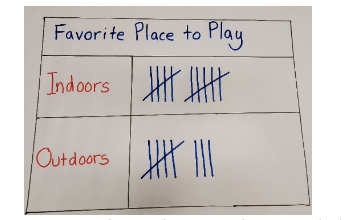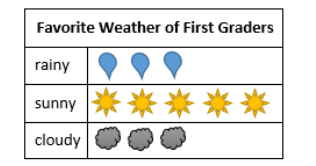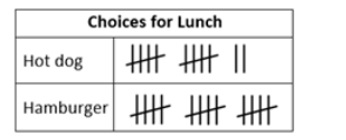Interpret data represented with tally marks or pictographs by calculating the total number of data points and comparing the totals of different categories.
Instruction focuses on the connection to addition and subtraction when calculating the total and comparing, respectively.
| Name |
Description |
| Hiring Drone Pilots | Students will recommend which drone pilots should be hired to inspect city roads for damage following a hurricane. They will determine the value of combinations of one, five, and ten dollar bills and interpret data represented by tally marks in a table.
This is an open-ended engineering design lesson where students will develop a model to help them solve a problem. There are no “right” answers as the lesson is focused on the process of developing a solution and the skills and reasoning behind the process. Students should be given the freedom to interpret the problem and parameters in unique ways to pursue their own lines of thinking in producing a solution. |
| How does Generative AI work? | Students will explore Artificial Intelligence (AI) and the basics on how generative AI models use Large Language Models (LLMs) and Natural Language Processing NLP to generate outputs. This K-3 lesson is an integrated Computer Science, ELA and Math lesson designed for application of math and ELA content knowledge while exploring and using computational thinking to understand how generative AI works, making cross-curricular connections to understand emerging technologies. |
| Lesson 3 - Tally Our Vote | Lesson 3 - Tally Our Vote |
| Lesson 2 - Tally the Vote | In this lesson, students will discuss how a class of students can vote to make a decision when they don't all agree on a choice. Students will count tallies to determine answers to questions about voting for a class pet. This is lesson 2 in a 3-part series integrating math and civics. |
| Class Pet Vote | Students will vote on a favorite class pet, record results, and use the most popular choice to decide the favorite as a way of demonstrating group decision making. |
| Tally Patriotism | Students will collect, record, and compare data about their favorite way to demonstrate patriotism during a patriotic holiday or observance. |
| Fairycat Bookstore | In this Model Eliciting Activity, MEA, students will work in small groups to determine a procedure for deciding which book series they would like in their classroom library. Students will use information presented in pictographs and tally charts to determine this ranking. Then, in the twist, students will have to consider the cost of the series and what they will learn from each.
Model Eliciting Activities, MEAs, are open-ended, interdisciplinary problem-solving activities that are meant to reveal students’ thinking about the concepts embedded in realistic situations. MEAs resemble engineering problems and encourage students to create solutions in the form of mathematical and scientific models. Students work in teams to apply their knowledge of science and mathematics to solve an open-ended problem, while considering constraints and tradeoffs. Students integrate their ELA skills into MEAs as they are asked to clearly document their thought process. MEAs follow a problem-based, student centered approach to learning, where students are encouraged to grapple with the problem while the teacher acts as a facilitator. To learn more about MEA’s visit: https://www.cpalms.org/cpalms/mea.aspx |
| Get Up and Move! | In this Model Eliciting Activity, MEA, students will work together to problem solve. The students are presented with a problem in which they have to decide on a procedure for choosing the activity that should be done at a Move-a-Thon fundraiser. Students will organize data in a tally chart as well as a pictograph. In the “twist” students will be given combinations of bills representing the value of each of the activities. Students will work together to reevaluate their original procedure and determine if it should change, along with the rankings.
Model Eliciting Activities, MEAs, are open-ended, interdisciplinary problem-solving activities that are meant to reveal students’ thinking about the concepts embedded in realistic situations. MEAs resemble engineering problems and encourage students to create solutions in the form of mathematical and scientific models. Students work in teams to apply their knowledge of science and mathematics to solve an open-ended problem, while considering constraints and tradeoffs. Students integrate their ELA skills into MEAs as they are asked to clearly document their thought process. MEAs follow a problem-based, student centered approach to learning, where students are encouraged to grapple with the problem while the teacher acts as a facilitator. To learn more about MEA’s visit: https://www.cpalms.org/cpalms/mea.aspx |
| Adopt-A-Road | In this Model Eliciting Activity, MEA, students will use a realistic scenario in order to analyze the steps for adopting a road in their own community. The students will be required to activate prior knowledge about litter and natural habitats, brainstorm independently, and also collaborate within cooperative groups to create a written procedure to explain their reasoning. Students will take into consideration wildlife, traffic, the amount of litter, and the length of the road (which affects the cost of clean-up).
Model Eliciting Activities, MEAs, are open-ended, interdisciplinary problem-solving activities that are meant to reveal students’ thinking about the concepts embedded in realistic situations. MEAs resemble engineering problems and encourage students to create solutions in the form of mathematical and scientific models. Students work in teams to apply their knowledge of science and mathematics to solve an open-ended problem, while considering constraints and tradeoffs. Students integrate their ELA skills into MEAs as they are asked to clearly document their thought process. MEAs follow a problem-based, student centered approach to learning, where students are encouraged to grapple with the problem while the teacher acts as a facilitator. To learn more about MEA’s visit: https://www.cpalms.org/cpalms/mea.aspx |
| Traveling With Clifford | In this MEA lesson plan, students will work on their map skills while they practice collecting data in categories, representing data using pictographs, and interpreting data in pictographs to solve a problem. Students will read and/or listen to the story Clifford Takes a Trip. After discussing the story, they will then plan a trip for Clifford to visit the great state of Florida. |
| Pictographs with Pizazz | In this lesson, students will create pictographs to represent data sets with up to four categories. They will use their graphs to solve addition, subtraction, and comparison problems. |
| Flower Power Flower Company MEA & STEAM* Activity | This STEAM (Science, Technology, Engineering, Art, and Math) lesson has been designed around a Model-Eliciting Activity.
The Flower Power MEA provides students with an real world problem in which they must work as a team to design a plan to select the best flower arrangement for a special event. The resource was primarily designed as an MEA so the time and teacher instructions are based on the MEA format. The additional activities will take several hours of instruction but include watching and discussing a video about the parts of plants, reading a book, and discussing the art in the book as well as additional art by the book author/illustrator. Model Eliciting Activities, MEAs, are open-ended, interdisciplinary problem-solving activities that are meant to reveal students’ thinking about the concepts embedded in realistic situations. Click here to learn more about MEAs and how they can transform your classroom. |
| Life Jackets | In this Model Eliciting Activity, MEA, the students are to decide what criteria is the most important for a company to consider when choosing life jackets. Students will use tally charts with data about comfort and visibility as well as information provided on 3D figures that can be used to model the life jackets.
Model Eliciting Activities, MEAs, are open-ended, interdisciplinary problem-solving activities that are meant to reveal students’ thinking about the concepts embedded in realistic situations. MEAs resemble engineering problems and encourage students to create solutions in the form of mathematical and scientific models. Students work in teams to apply their knowledge of science and mathematics to solve an open-ended problem, while considering constraints and tradeoffs. Students integrate their ELA skills into MEAs as they are asked to clearly document their thought process. MEAs follow a problem-based, student centered approach to learning, where students are encouraged to grapple with the problem while the teacher acts as a facilitator. To learn more about MEA’s visit: https://www.cpalms.org/cpalms/mea.aspx |
| Noritos Chip Company | In this Model Eliciting Activity, MEA, the students will use data given in a tally chart and pictograph to help a chip company determine which new flavor of chips it should sell. Students will analyze the data and determine a procedure for ranking the chips. In the “twist,” students will be given the number of calories to compare and take into account for their procedure for ranking.
.
Model Eliciting Activities, MEAs, are open-ended, interdisciplinary problem-solving activities that are meant to reveal students’ thinking about the concepts embedded in realistic situations. MEAs resemble engineering problems and encourage students to create solutions in the form of mathematical and scientific models. Students work in teams to apply their knowledge of science and mathematics to solve an open-ended problem, while considering constraints and tradeoffs. Students integrate their ELA skills into MEAs as they are asked to clearly document their thought process. MEAs follow a problem-based, student centered approach to learning, where students are encouraged to grapple with the problem while the teacher acts as a facilitator. To learn more about MEA’s visit: https://www.cpalms.org/cpalms/mea.aspx |
| Crumbly Cookie Company | Students will determine the best variety for a new cookie entering the market. Students will have to consider flavor, smell, appearance, and the number of cookies in the package. Model Eliciting Activities, MEAs, are open-ended, interdisciplinary problem-solving activities that are meant to reveal students’ thinking about the concepts embedded in realistic situations. Click here to learn more about MEAs and how they can transform your classroom. |
| Planting Vegetables After a Storm | In this open-ended question, students in teams will make decisions about how to rank vegetables to plant on a farm. The students' decisions will be based on various criteria.
Model Eliciting Activities, MEAs, are open-ended, interdisciplinary problem-solving activities that are meant to reveal students’ thinking about the concepts embedded in realistic situations. MEAs resemble engineering problems and encourage students to create solutions in the form of mathematical and scientific models. Students work in teams to apply their knowledge of science and mathematics to solve an open-ended problem, while considering constraints and tradeoffs. Students integrate their ELA skills into MEAs as they are asked to clearly document their thought process. MEAs follow a problem-based, student centered approach to learning, where students are encouraged to grapple with the problem while the teacher acts as a facilitator. To learn more about MEA’s visit: https://www.cpalms.org/cpalms/mea.aspx |
| Zaspper Baby Fun Toy Company | In this Model Eliciting Activity, MEA, students will work together to determine a procedure for ranking toys for a company. They will use data presented in a tally chart, count money, and consider information in tables.
Model Eliciting Activities, MEAs, are open-ended, interdisciplinary problem-solving activities that are meant to reveal students’ thinking about the concepts embedded in realistic situations. MEAs resemble engineering problems and encourage students to create solutions in the form of mathematical and scientific models. Students work in teams to apply their knowledge of science and mathematics to solve an open-ended problem, while considering constraints and tradeoffs. Students integrate their ELA skills into MEAs as they are asked to clearly document their thought process. MEAs follow a problem-based, student centered approach to learning, where students are encouraged to grapple with the problem while the teacher acts as a facilitator. To learn more about MEA’s visit: https://www.cpalms.org/cpalms/mea.aspx
|
| Vote for Ice Cream | Students will collect and represent data about their favorite ice cream flavors by creating a class tally chart. The students will then work in pairs to use the same data to create a pictograph. Students will use the data displays to answer questions about the total number of data points and to compare the categories. |





